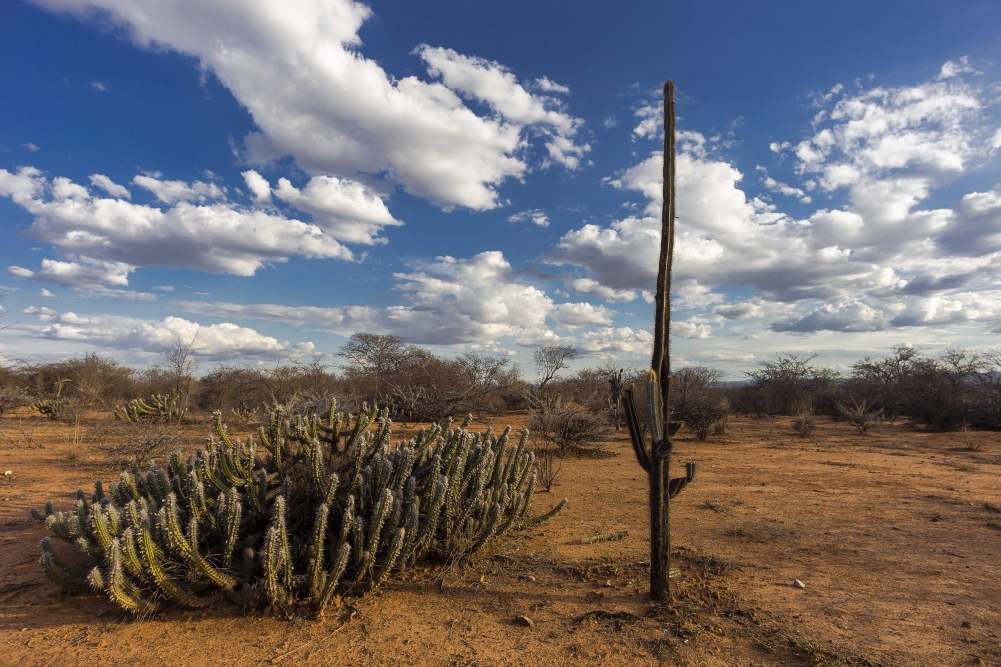


Climate change is likely to transform the Caatinga’s vegetation, making it sparser and scrubbier by 2060 (photo: Giancarlo Zorzin)
Published on 09/18/2023
By Julia Moióli | Agência FAPESP – The consequences of climate change in the Caatinga, the semi-arid shrubland and thorn forest biome in Brazil’s Northeast region, will include species loss, substitution of rare plants by more generalist vegetation, biotic homogenization (in which previously distinct plant communities become progressively more similar), increasing aridity, and even desertification in some areas.
These are some of the findings of a study reported in the Journal of Ecology by Brazilian researchers affiliated with the State University of Campinas (UNICAMP), the Federal University of Paraíba (UFPB), the Federal University of Pernambuco (UFPE), the Federal University of Viçosa (UFV) and the Federal Institute of Goiás (IFG).
The study was supported by FAPESP via two projects (22/12231-6 and 21/11840-6).
The researchers surveyed plant collections, herbariums and the scientific literature to compile a database of more than 400,000 occurrence records for some 3,000 plant species in the biome. They combined all this with data for geographic distribution, growth form, climate and soil. They then grouped the species into two categories: woody (trees, shrubs, palms, and woody vines); and non-woody (herbs, herbaceous vines, and succulents).
Using models evaluated and validated with different types of statistical algorithm and artificial intelligence, they arrived at more than a million projections of the possible responses of plant species in the Caatinga to future climate variations.
“We based our projections on the simulations in the latest report of the Intergovernmental Panel on Climate Change [IPCC], issued in 2021,” said Mario Ribeiro de Moura, first author of the article and a researcher at UNICAMP. “However, given that we don’t know how humanity will behave from now on, we considered two scenarios: an optimistic scenario, assuming that technology reduces greenhouse gas emissions and the Paris Agreement is implemented [limiting the average global temperature rise to 1.5 °C above the pre-industrial level]; and a pessimistic scenario, under which deforestation rates, fossil fuel use and population growth remain high and there are no advances in innovation.”
The results showed that 99% of plant assemblages in the Caatinga will lose species by 2060. Increasing aridity and rising temperatures will decrease vegetation diversity and complexity. The hot dry climate will be particularly adverse for trees, many of which will be replaced by shrubs and grasses because it will be easier for them to grow and spread. All this will also affect ecosystem services such as photosynthesis, air renewal and carbon storage in tree leaves, trunks and roots.
These events will be most visible in mountainous areas such as Chapada Diamantina and Chapada do Araripe, in the southern and mid-northern parts of the biome respectively. The explanation is simple: lowland species will migrate to higher ground as temperatures rise, while highland species will become extinct. “For the biome as a whole, we predict extinction of 50 plant species under the optimistic scenario and 250 under the pessimistic scenario. Both are alarming,” Moura said.
Biotic homogenization will affect some 40% of plant assemblages, simplifying their composition owing to loss of rare species. “It’s as if you took the landscape and put it into a blender to homogenize everything,” he said.
Mitigation projects
The researchers hope the different tiers of government will use their findings to draw up long-term macroscale conservation plans. This type of strategy is important to mitigate the adverse effects of climate change and those of human activity, such as deforestation, habitat destruction, and soil degradation and exposure.
“Projects designed to restore landscape connectivity in areas subject to the impact of climate change, for example, increase the probability that species living there will be able to disperse over time to more suitable areas, via animals or wind. On the other hand, if biodiversity is too badly affected by degradation, deforestation, use of agrochemicals and poaching, resources will be even more compromised from now on,” Moura said.
The article “Pervasive impacts of climate change on the woodiness and ecological generalism of dry forest plant assemblages” is at: besjournals.onlinelibrary.wiley.com/doi/epdf/10.1111/1365-2745.14139.
Source: https://agencia.fapesp.br/44876